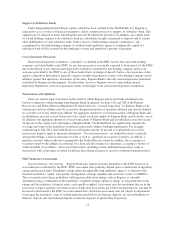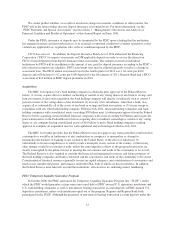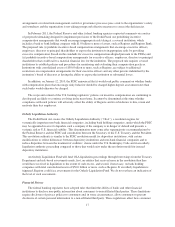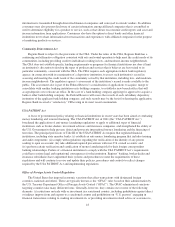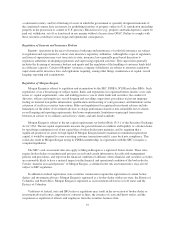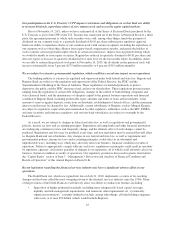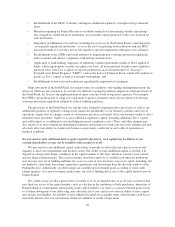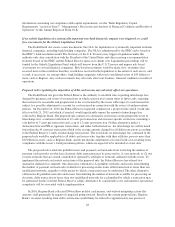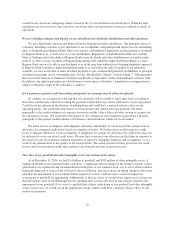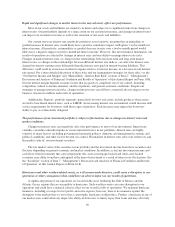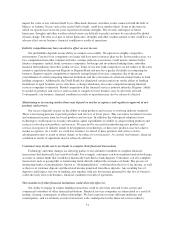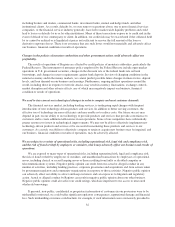Regions Bank 2010 Annual Report Download - page 36
Download and view the complete annual report
Please find page 36 of the 2010 Regions Bank annual report below. You can navigate through the pages in the report by either clicking on the pages listed below, or by using the keyword search tool below to find specific information within the annual report.The decreases in our credit rating over the past two years, our status as a non-investment grade issuer and
any future decrease in our credit ratings by one or more ratings agencies could impact our access to the capital
markets or short-term funding or increase our financing costs, and thereby adversely affect Regions’ financial
condition and liquidity. Where Regions Bank is providing forms of credit support such as letters of credit,
standby lending arrangements or other forms of credit support, this recent decline and future declines may cause
customers of Regions to seek replacement credit support from a higher rated institution and may limit our ability
to compete for future business. Our counterparties are also sensitive to the risk of a ratings downgrade and have
the ability to terminate or may be less likely to engage in transactions with us, or may only engage in transactions
with us at a substantially higher cost. We cannot predict whether customer relationships or opportunities for
future relationships could be adversely affected by customers who choose to do business with a higher rated
institution. The inability to retain customers or to effectively compete for new business may have a material and
adverse effect on Regions’ business, financial condition and results of operations.
Additionally, ratings agencies have themselves been subject to scrutiny arising from the financial crisis such
that the rating agencies may make or may be required to make substantial changes to their ratings policies and
practices. Such changes may, among other things, adversely affect the ratings of our securities or other securities
in which we have an economic interest.
The value of our deferred tax assets could adversely affect our operating results and regulatory capital ratios.
As of December 31, 2010, Regions had approximately $1.4 billion in net deferred tax assets, of which $424
million was disallowed when calculating regulatory capital. Applicable banking regulations permit us to include
these deferred tax assets, up to a maximum amount, when calculating Regions’ regulatory capital to the extent
these assets will be realized based on future projected earnings within one year of the report date. The ability to
realize these deferred tax assets during any year also includes the ability to apply these assets to offset any
taxable income during the two previous years. Unless we anticipate generating sufficient taxable income in the
future, we may be unable to include additional amounts related to our deferred tax assets as part of our regulatory
capital. The inability to include deferred tax assets in our regulatory capital could significantly reduce our
regulatory capital ratios.
Additionally, our deferred tax assets are subject to an evaluation of whether it is more likely than not that
they will be realized for financial statement purposes. In making this determination we consider all positive and
negative evidence available including the impact of recent operating results as well as potential carryback of tax
to prior years taxable income, reversals of existing taxable temporary differences, tax planning strategies and
projected earnings within the statutory tax loss carryover period. We have determined that the deferred tax assets
are more likely than not to be realized at December 31, 2010 (except for $30 million related to state deferred tax
assets for which we have established a valuation allowance). If we were to conclude that a significant portion of
our deferred tax assets were not more likely than not to be realized, the required valuation allowance could
adversely affect our financial position and results of operations.
We have been the subject of increased litigation which could result in legal liability and damage to our
reputation.
We and certain of our subsidiaries have been named from time to time as defendants in various class actions
and other litigation relating to their business and activities. Past, present and future litigation have included or
could include claims for substantial compensatory or punitive damages or claims for indeterminate amounts of
damages. We and certain of our subsidiaries are also involved from time to time in other reviews, investigations
and proceedings (both formal and informal) by governmental and self-regulatory agencies regarding their
business. These matters also could result in adverse judgments, settlements, fines, penalties, injunctions or other
relief.
In addition, in recent years, a number of judicial decisions have upheld the right of borrowers to sue lending
institutions on the basis of various evolving legal theories, collectively termed “lender liability.” Generally,
22



